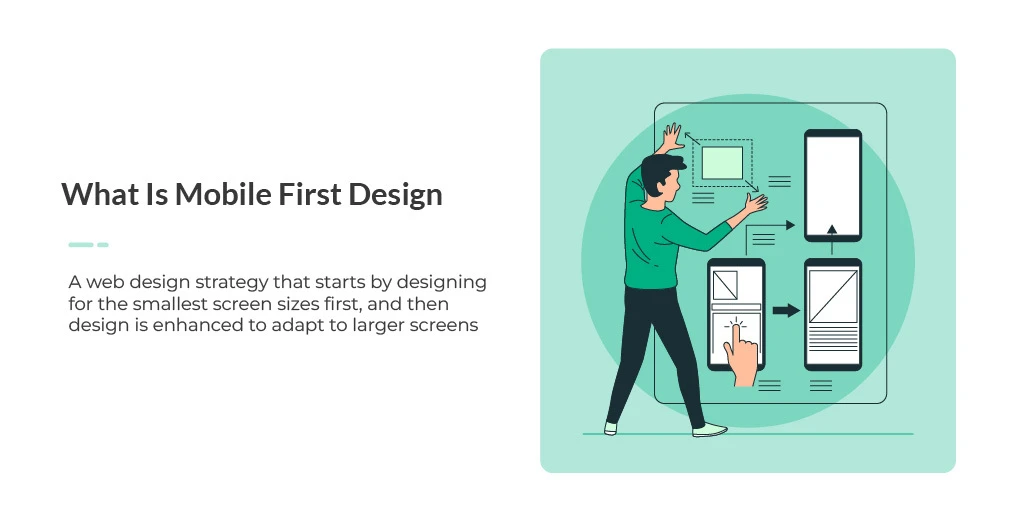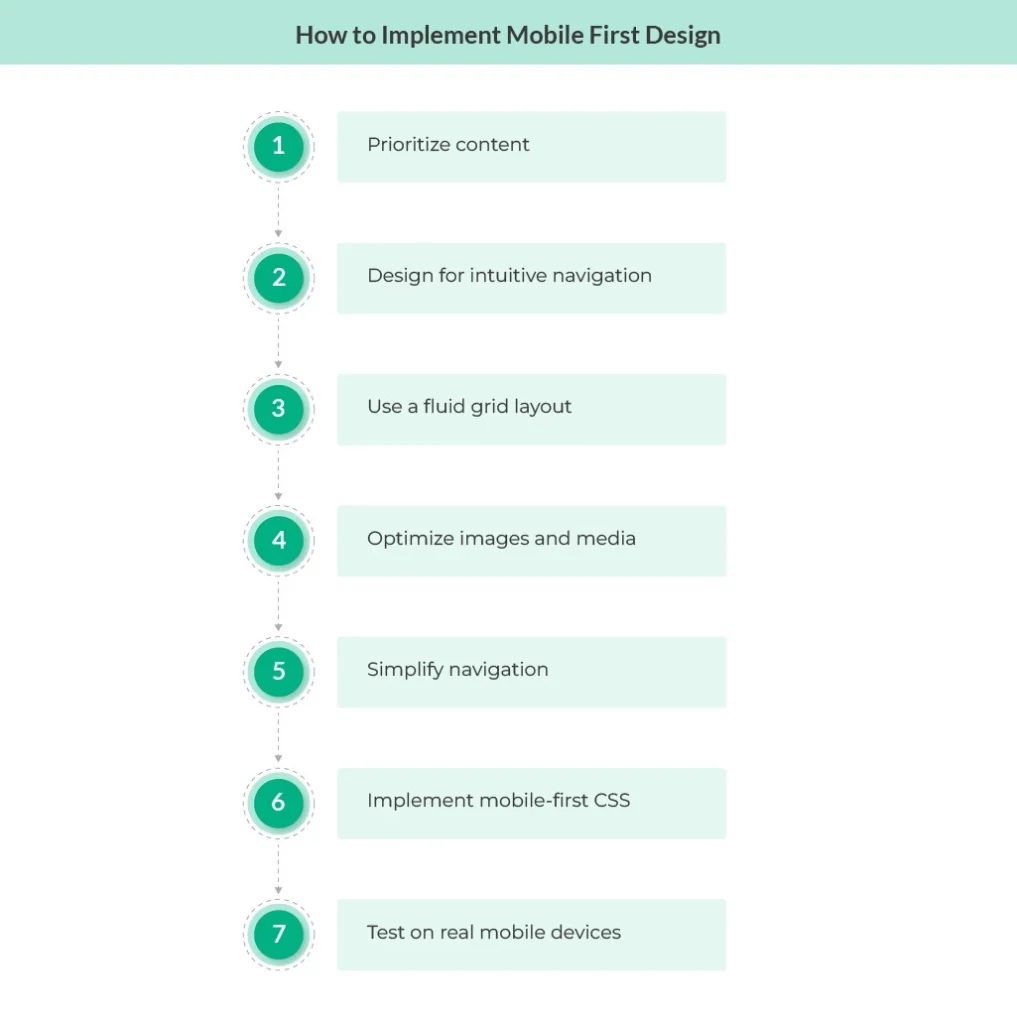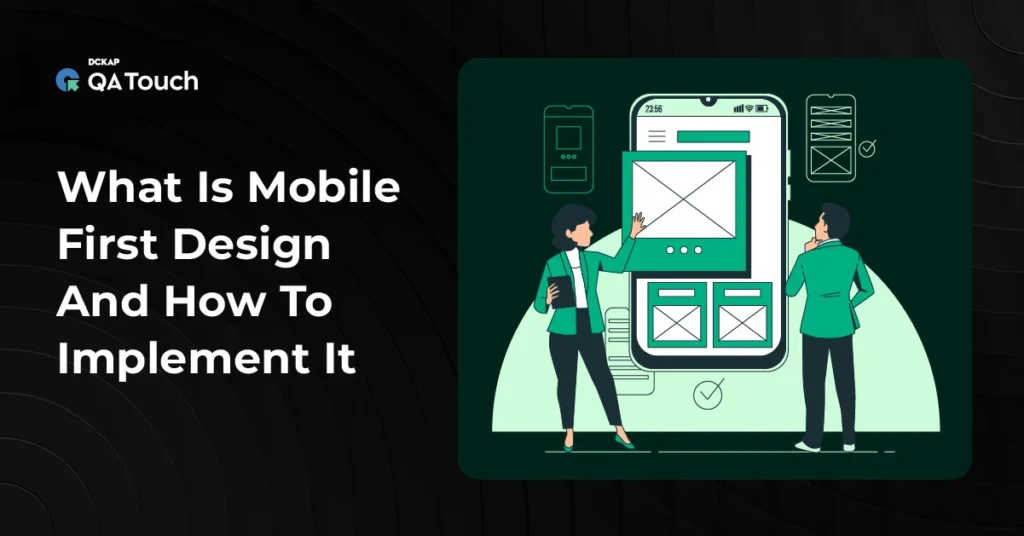Mobile devices have become the primary way people access websites today. As a result, designers and developers must shift their focus to create designs that prioritize mobile users. This approach, known as Mobile First Design, not only improves user experience but also has SEO benefits and ensures faster load times. In this blog, we’ll explore what Mobile First Design is, why it matters, and how you can implement it effectively for a better mobile experience.
What Is Mobile First Design?
 Mobile First Design is a web design strategy that starts by designing for the smallest screen sizes first, and then progressively enhancing the design to adapt to larger screens such as tablets and desktops. Instead of starting with a desktop layout and then resizing it for mobile, this approach flips the process. The focus is on delivering a clean, user-friendly experience optimized for mobile devices before expanding it to larger screens.
Mobile First Design is a web design strategy that starts by designing for the smallest screen sizes first, and then progressively enhancing the design to adapt to larger screens such as tablets and desktops. Instead of starting with a desktop layout and then resizing it for mobile, this approach flips the process. The focus is on delivering a clean, user-friendly experience optimized for mobile devices before expanding it to larger screens.
Also Read: A Comprehensive Guide To Mobile App Testing
Mobile First Design Example
Let’s take a look at an example to help clarify the concept of Mobile First Design. Imagine you’re designing a news website. On a mobile-first design, you would begin by focusing on the most important elements: the headline, a short summary of the story, and a clean, easy-to-navigate menu.
As you scale up to a tablet or desktop, you can add additional features like a sidebar for related stories, images, or even more detailed navigation options. This ensures that the most important content is front and center on mobile, but as the screen size increases, you can enhance the design without overwhelming the user.
Why Is Mobile First Design Important In Product Design?
 Mobile First Design has become a crucial strategy for web designers and developers, and for good reason. Here are some of the key factors that make it so important:
Mobile First Design has become a crucial strategy for web designers and developers, and for good reason. Here are some of the key factors that make it so important:
- User Behavior: More people are accessing websites through mobile devices than ever before. By focusing on mobile-first design, you’ll be meeting the expectations of these mobile users and ensuring they get the best experience possible on the devices they use most. Prioritizing mobile first means you’re designing with your audience in mind, making it easier for them to navigate your site.
- Mobile-First Indexing: Google’s mobile-first indexing means that Google primarily uses the mobile version of your website for ranking in search results. By adopting Mobile First Design, you’ll ensure your site is optimized for SEO and has a better chance of ranking well on search engines.
- Faster Load Times: Mobile First Design encourages optimization, which leads to faster load times. By focusing on mobile first, you’ll be streamlining the site’s design, making it perform better and load quicker across all devices. Faster load times mean better user satisfaction and improved SEO performance, which are both essential for success.
- Improved Accessibility: Designing with mobile users in mind means you’re ensuring the website is accessible to a broader audience, especially those using smaller screens and touch-based interactions. Mobile First Design emphasizes simplicity and usability, which enhances the accessibility of your site for everyone, including people with disabilities. By doing so, you’ll expand the reach of your website and provide a more inclusive experience for all users.
How to Implement Mobile First Design?
 Implementing Mobile First Design can seem like a big task, but with a step-by-step approach, you can create a seamless mobile experience that scales flawlessly across all devices. Here’s a detailed guide on how to implement Mobile First Design effectively:
Implementing Mobile First Design can seem like a big task, but with a step-by-step approach, you can create a seamless mobile experience that scales flawlessly across all devices. Here’s a detailed guide on how to implement Mobile First Design effectively:
Step 1: Start with Content Prioritization
The first step in implementing Mobile First Design is identifying the most essential content and features that need to be displayed on a mobile screen. Mobile screens are limited in space, so it’s critical to prioritize the most important elements of your site to ensure users have a streamlined experience. This means focusing on what truly matters to your audience.
- Identify high-priority content: Think about what users need to see right away when they visit your site. For instance, if you’re designing an e-commerce site, you may want to prioritize product categories, search bar, and call-to-action buttons such as “Add to Cart.”
- Eliminate unnecessary elements: Avoid adding too many decorative elements or complex features that may clutter the screen. Keep things simple and easy to navigate.
Step 2: Design for Touchscreen Interaction
Since mobile devices primarily rely on touchscreen interaction, your design must accommodate touch-based navigation. Mobile First Design emphasizes creating elements that are easy to interact with, ensuring users have a smooth experience when tapping, swiping, or scrolling.
- Ensure buttons are large enough to tap: Small buttons or links can be difficult for users to tap accurately. Make sure buttons are large enough for easy tap interaction. A good rule of thumb is to make sure buttons are at least 44px by 44px.
- Create swipe-friendly navigation: Since mobile users interact by swiping, designing menus and navigation to accommodate swipe gestures will enhance the user experience. You can implement swipeable menus or carousel elements that make it easier for users to explore content with simple gestures.
Step 3: Use a Fluid Grid Layout
A flexible, fluid grid layout is crucial in Mobile First Design because it ensures your design adapts to different screen sizes. This is the key to creating a responsive website that works seamlessly across mobile, tablet, and desktop devices.
- Use percentage-based widths instead of fixed pixel widths: This allows the design elements to resize and adjust based on the screen size. For example, using percentages for widths will allow elements to stretch and shrink accordingly.
- Ensure elements resize and adjust to various devices: Design your layout so that text, images, and content automatically adjust to look great on any screen. This reduces the need for excessive zooming or horizontal scrolling on smaller screens.
Step 4: Optimize Images and Media
Mobile devices often have slower network speeds compared to desktop devices, so optimizing images and media files is a critical step in Mobile First Design. The goal is to ensure fast load times and avoid draining mobile data.
- Compress images and media: Large images can slow down load times, which could frustrate users. Compress your images and other media files without sacrificing quality to ensure faster loading speeds.
- Use responsive images: Implement responsive images that automatically scale according to the screen size and resolution. This ensures that users aren’t downloading unnecessarily large files on smaller devices.
- Use lightweight formats: Choose image and video formats that are optimized for the web, like WebP for images or MP4 for videos, to keep file sizes small while maintaining quality.
Step 5: Simplify Navigation
One of the biggest challenges on mobile is designing navigation that works seamlessly on small screens. Mobile First Design simplifies navigation to ensure it’s both easy to use and doesn’t take up too much space.
- Use a hamburger or accordion menu: These menus are compact and can hide multiple navigation options behind a simple icon. This maximizes available screen space while keeping navigation accessible.
- Implement sticky navigation bars: A sticky navigation bar allows users to access the main menu no matter where they are on the page. This makes navigation easier and keeps important elements like call-to-action buttons visible at all times.
Step 6: Implement Mobile-First CSS
Mobile First Design requires writing CSS (Cascading Style Sheets) that starts with styles optimized for mobile devices. From there, you can progressively enhance the design for larger screens, ensuring the mobile experience is prioritized first.
- Use media queries to adjust layout and elements based on screen size: Media queries allow you to apply different styles for different screen sizes. Start with mobile styles (typically for screens smaller than 600px) and add additional rules for larger screens.
- Ensure that mobile users see optimized content first: When writing CSS, ensure the mobile version of the website looks great and is fully functional before adding enhancements for tablet or desktop screens. This ensures users on mobile devices receive the best experience from the start.
Step 7: Test on Real Mobile Devices
After implementing the design, testing on real mobile devices is essential to ensure the website works as intended. Emulators and simulators are helpful, but testing on actual devices gives you a true sense of how the design will behave in the real world.
- Test across different screen sizes and operating systems: Mobile devices vary widely in terms of screen sizes and operating systems (iOS, Android), so it’s important to test your design on multiple devices to ensure compatibility.
- Address any user interface (UI) issues: As you test, pay close attention to any UI issues such as layout problems, broken links, or unresponsive elements. These need to be fixed before launch to provide a flawless experience for all users.
Also Read: Functional Test vs Integration Test: What’s the Difference?
Best Tools for Mobile-First Design
When it comes to implementing Mobile First Design, having the right tools can make all the difference. Here are some of the top tools that can help you design and optimize for mobile-first experiences:
- Sketch: A powerful design tool that is widely used by web designers and developers for creating responsive, mobile-first designs. Sketch offers a range of features for wireframing, prototyping, and creating vector-based designs that scale beautifully across different screen sizes.
- Figma: A cloud-based design tool that allows for seamless collaboration between team members. Figma’s real-time editing and design systems are perfect for creating mobile-first designs that need to be responsive and scalable. It also integrates with other tools to streamline your workflow.
- Adobe XD: Adobe XD offers an intuitive design and prototyping interface that helps you build mobile-first layouts quickly. With its powerful responsive resize feature, Adobe XD allows you to create designs that automatically adjust to different screen sizes, ensuring a smooth transition from mobile to desktop views.
- Chrome DevTools: While primarily a developer tool, Chrome DevTools offers powerful features for testing and debugging responsive designs. It allows you to simulate mobile devices, inspect elements, and see how your design behaves on various screen sizes, helping you fine-tune your mobile-first design in real-time.
Mobile First Design vs. Responsive Design
Mobile First Design is the more future-proof approach, ensuring that you are ready for new devices and delivering an optimal experience to the largest audience possible.
| Aspect | Mobile First Design | Responsive Design |
| Approach | Starts by designing for the smallest screens first, then progressively enhances the design for larger screens. | Adjusts the layout and content based on screen size, but doesn’t prioritize mobile first. |
| Focus | Focuses on delivering an optimal mobile experience first and then scales up for tablets and desktops. | Focuses on creating a flexible design that adapts to various screen sizes, but mobile may not be prioritized. |
| Design Process | Begins with the essential content and features, ensuring mobile users get a streamlined, optimized experience. | Designs for desktop or larger screens first, then adapts for smaller screens through media queries. |
| Content Prioritization | Prioritizes core content and functionality for mobile, ensuring a clean and concise design for small screens. | Content is prioritized for larger screens first, and adjustments are made for mobile devices later. |
| SEO Impact | Helps with mobile-first indexing, improving SEO rankings as Google prioritizes mobile-optimized sites. | Mobile optimization is added after the desktop design, potentially impacting SEO for mobile-first indexing. |
| Performance | Optimizes images and content to ensure fast load times on mobile devices, which leads to better performance across all devices. | Performance depends on adapting a larger design for smaller screens, which may not be as optimized for speed. |
| Flexibility | Highly flexible and adaptable for various screen sizes as it starts with mobile and progressively enhances. | Responsive to screen size changes but may not be as flexible in terms of mobile-first optimization. |
Why Mobile First Design is More Future-Proof?
- Mobile-Centric World: With mobile traffic increasing and becoming the primary source of internet browsing, designing mobile-first ensures you’re meeting the growing demand for optimized mobile experiences.
- SEO & Google Prioritization: As Google uses mobile-first indexing, prioritizing mobile-first design ensures your site ranks higher in search results, giving you a competitive edge.
- Optimized User Experience: Mobile First Design ensures that users on mobile devices receive a fast, smooth, and user-friendly experience, enhancing engagement and satisfaction.
Benefits of Mobile First Design
 Adopting Mobile First Design comes with several key advantages that can enhance the overall performance and user experience of your website or application. Here are the primary benefits:
Adopting Mobile First Design comes with several key advantages that can enhance the overall performance and user experience of your website or application. Here are the primary benefits:
Improved User Experience
Mobile First Design focuses on delivering a clean, functional, and intuitive experience for mobile users, ensuring that the website or app is user-friendly, regardless of the device. By designing with mobile users in mind first, it guarantees that the most important content and features are easily accessible, leading to increased satisfaction and engagement.
Better SEO Performance
As Google continues to prioritize mobile-friendly websites with its mobile-first indexing, adopting a Mobile First Design strategy helps improve your SEO performance. Mobile-optimized websites are more likely to rank higher in search engine results, making it easier for potential customers or users to find your website.
Faster Load Times
Mobile First Design encourages the optimization of images, media, and content, which leads to faster load times on mobile devices. This not only improves the overall user experience but also boosts SEO, as page speed is a key ranking factor for search engines. Faster load times reduce bounce rates and enhance user retention.
Cost-Effective Development
By focusing on mobile first, you create a strong foundation for your design, which can then be easily scaled for larger devices such as tablets and desktops. This approach reduces the need for drastic redesigns and complex adjustments, making the development process more efficient and cost-effective in the long run. Additionally, it allows for quicker implementation of new features, saving both time and resources.
Challenges of Mobile First Design
While Mobile First Design offers numerous benefits, there are also some challenges that you may encounter when implementing it. Here are the primary hurdles and ways to overcome them:
Limited Screen Space
Mobile devices have much smaller screens compared to desktops or tablets, which means there is less room for displaying content. This can be challenging for content-heavy websites where you need to ensure that essential information is prioritized without overwhelming the user.
To overcome this, focus on content prioritization- identify the most important features and content that users need access to and make those the primary elements of the design. Avoid clutter and keep the interface clean and concise.
Complexity of Testing
Testing across various devices with different screen sizes, resolutions, and operating systems can be time-consuming. Ensuring that your mobile-first design looks and works well on a wide range of devices is crucial but can be difficult.
One way to streamline this process is by using responsive design testing tools (like Chrome DevTools or BrowserStack) to test how your design behaves on different devices and screen sizes. Additionally, ensure your testing covers various operating systems, browsers, and screen orientations to guarantee consistency and usability.
Compatibility Issues
Older devices or browsers may not fully support the latest web standards, leading to design and functionality issues. Some users may still be using older mobile devices or outdated browsers that may not render mobile-first designs properly.
To handle this, consider implementing graceful degradation or progressive enhancement. Design for the most widely used devices and browsers first, and then make sure the design still works on older versions by providing fallback options for those users. Using tools like Can I Use can help you check compatibility for various CSS, HTML, and JavaScript features.
Best Practices for Mobile First Design
To achieve the best results with Mobile First Design, it’s important to follow these best practices that will help you create an optimized, user-friendly experience for mobile users while ensuring that your design scales well to larger devices:
Focus on Simplicity and Prioritize Essential Content
Mobile screens are limited in space, so it’s crucial to keep the design clean and simple. Prioritize the most important content and features, ensuring they are easily accessible without clutter. Strip away any non-essential elements and focus on delivering a streamlined experience. By keeping the user interface minimal, you reduce the cognitive load on users, making navigation intuitive.
Design with Touch Interactions in Mind
Mobile devices rely heavily on touch-based interactions, so it’s essential to design your UI elements—such as buttons, menus, and forms—with this in mind. Ensure that buttons are large enough to tap easily, and make sure that clickable elements are well-spaced to prevent accidental clicks. Create swipe-friendly navigation for easy and intuitive interactions, enhancing the overall usability of the design.
Optimize for Speed by Minimizing Large Images and Media Files
Speed is crucial for mobile users, as slow-loading pages can lead to frustration and higher bounce rates. Compress images and optimize media files to minimize load times without sacrificing quality. Use responsive images that adjust in size according to the device, and choose lightweight file formats that load quickly, ensuring better performance and a smoother experience for mobile users.
Implement Progressive Enhancement Techniques
Start with a mobile-optimized design and then gradually enhance the design for larger screens like tablets and desktops. This approach ensures that the core features and content are available to all users on mobile first, while additional features can be progressively added as the screen size increases. This technique also improves the overall user experience on both small and large devices.
Test the Website on Real Mobile Devices Regularly
Testing on real mobile devices is essential to ensure that your design works as intended. While emulators and simulators are useful for initial testing, they don’t always provide an accurate representation of real-world performance. Regularly test your design across a variety of mobile devices, screen sizes, and operating systems to identify and fix any issues that may arise. This hands-on approach helps ensure a seamless user experience across all devices.
Conclusion
Mobile First Design isn’t just a trend, t’s a necessity for any website or application aiming to deliver a great user experience in a mobile-driven world. By prioritizing mobile users and focusing on simplicity and performance, you’re setting your website up for success. Implementing Mobile First Design may present challenges, but the benefits far outweigh them.
QA Touch is an effective test management platform that helps you streamline your testing processes via a single dashboard. From ChatGPT based test case creation to audit logs, in-built mindmap and more, leverage numerous benefits QA Touch has to offer.
Sign up today. It’s free till you upgrade.







